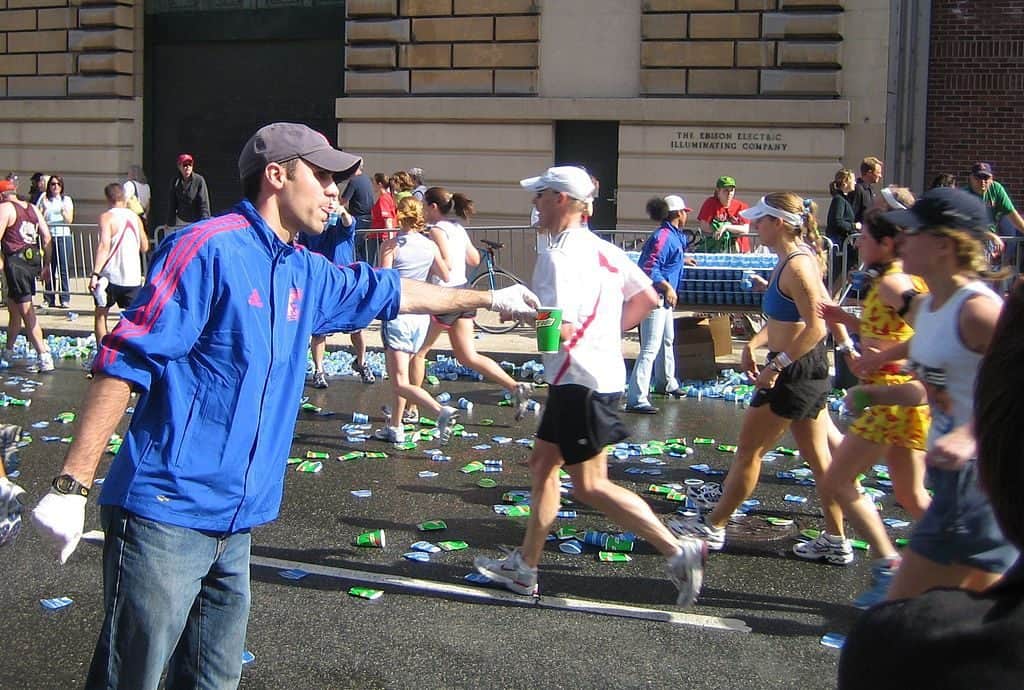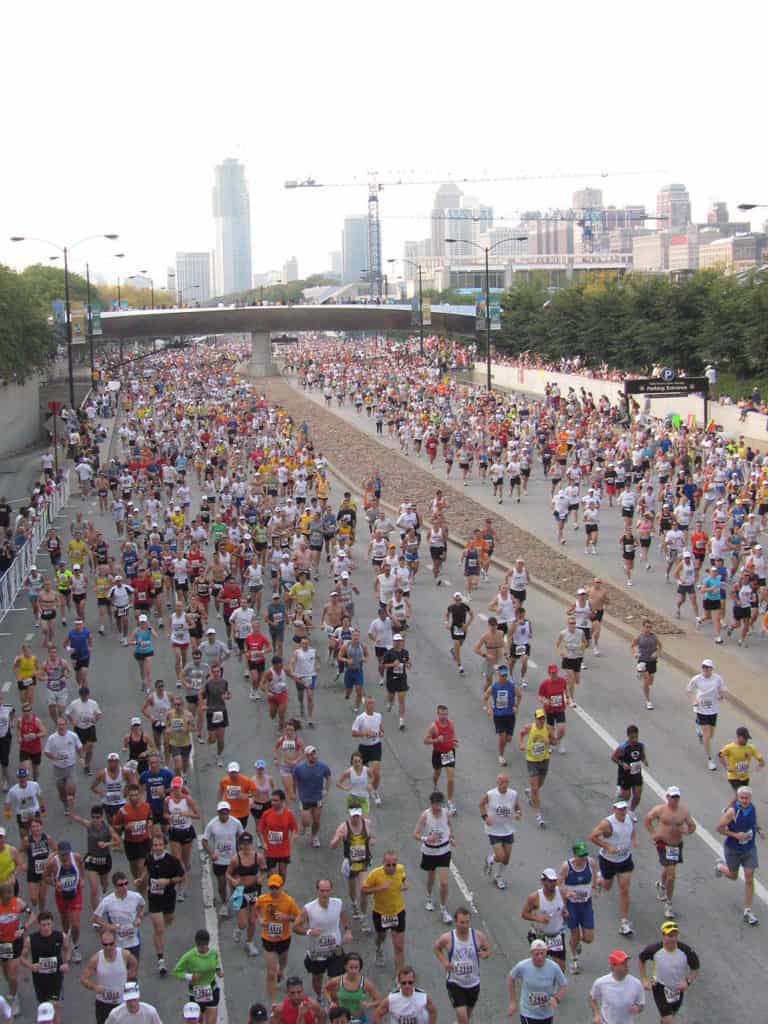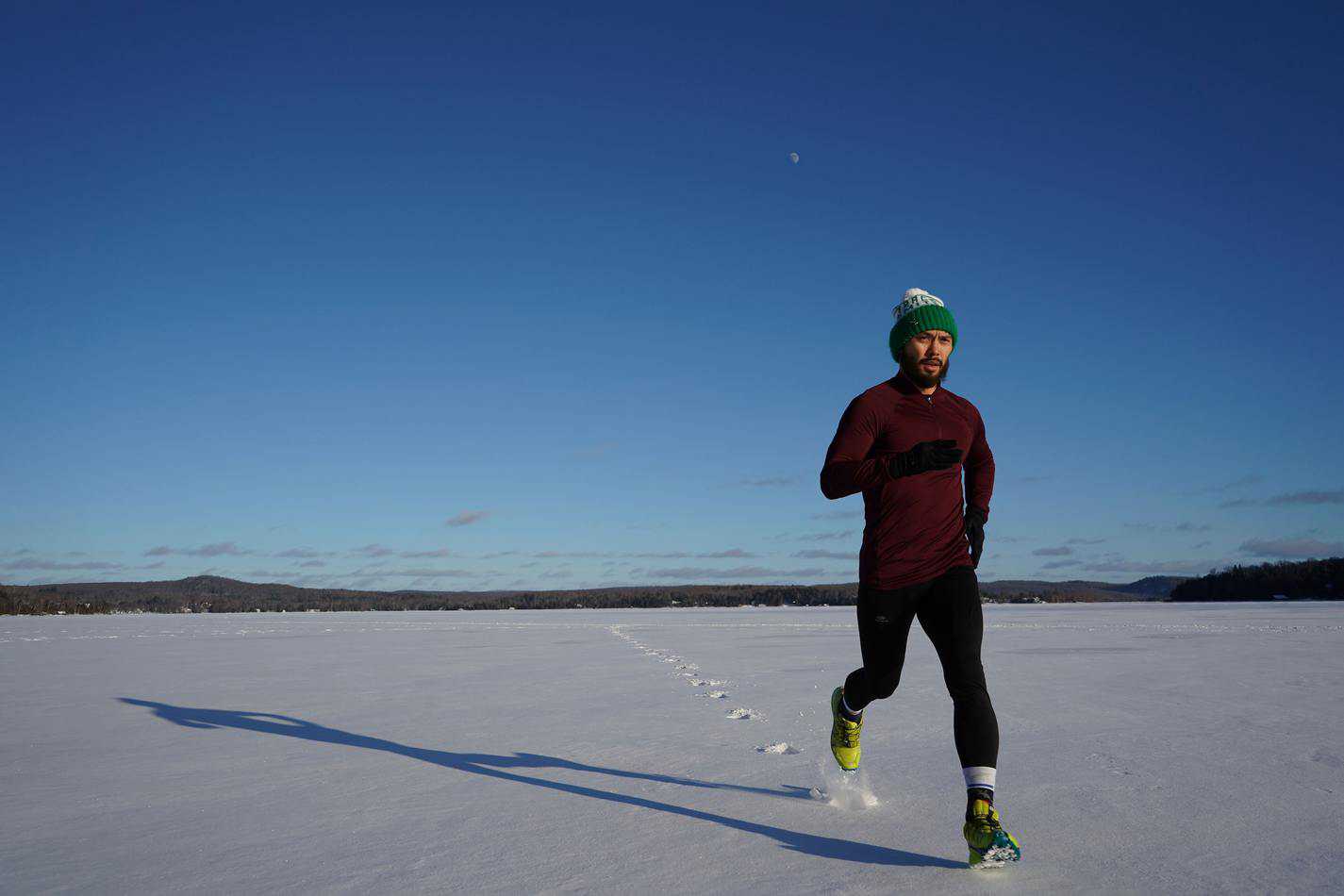Like almost any other sport, running doesn’t come without risk. Where it falls on the danger spectrum is obviously subjective and depends on a lot of different factors. Then there’s the question of how much you’re actually running. A simple jog sounds harmless enough, but running a marathon and all of the training that goes into is a different kind of beast. Yes, it’s tough and takes a considerable amount of physical and mental strength, but to call it dangerous…I’ve honestly never thought so. Then again, most people think I’m crazy for running marathons and maybe this is partially why.
Though I don’t feel like I’m putting my body in harm’s way by training for and running marathons, it can pose dangers when not approached correctly.
Here I’ll outline dangers associated with the marathon distance as well as what you can do to avoid them pertaining to:
- Am I healthy enough to run a marathon?
- Do I hydrate properly for marathon training?
- Is it too hot to be running a marathon?
- Am I running through injury when I shouldn’t be?
I want you to walk away from reading this understanding that running a marathon takes proper preparation to complete it safely. It’s not risk-free, but I certainly wouldn’t call it dangerous.
Running a Marathon – How dangerous is it?
Part of the danger myth that is perpetuated comes from the history of the marathon. People who want to exaggerate the dangers of running 26.2 miles often throw out the name of Pheidippides and how he died after running a similar distance to declare an Athenian victory over the Persian army. The story goes (you can read my article about it here) that he died immediately upon delivering the good news. But, for one, Pheidippides ran far more than 25 miles (supposedly an additional 140 miles on no sleep) and two, no one knows exactly how much truth there is to the story anyway. Using that as the basis for an argument to prove that running a marathon in the 21st century is dangerous really doesn’t make any sense.
If we want to talk real facts, here’s one. The New England Journal of Medicine reported that death while running a half or full-marathon is extremely rare. During the decade of 2000-2010, only 42 runners out of nearly 11 million died of cardiac arrest (when the heart stops working). That equates to an extremely small percentage of 0.00039 percent. In the tragic event that a runner does die, such was the case in the heat of the 2007 Chicago Marathon, the media reports on it immediately. This drastically skews public perception – making it seem as if death during a marathon is not all that uncommon.
So, saying the chance of dying while running a marathon is minuscule would be an understatement. It can happen, but not at a higher rate than most other forms of exercise.
Hyponatremia and heat-related illness can be life-threatening as well, but again, are extremely rare. Precautions can be taken to avoid all of these risks and I’ll discuss that coming up.

Step 1: Get a Check-Up
Starting a new cardiovascular program should always start with a visit to your doctor. Anyone who is considering running a marathon should first undergo a physical exam. Only a doctor can tell you if you are healthy enough to do so. And most people will be! But you need to get an expert opinion first.
Anyone with a family history of heart problems, in particular, need to be extra vigilant about routine check-ups. Even though the risk of cardiac arrest is low during a marathon, runners also have to consider the number of long runs they will have to perform beforehand as well which increases the risk. Marathons are safe for the majority of the population. But, anyone who may be at risk for heart disease has to be careful.
The 40 and over age group is also strongly encouraged to request an “echo stress test.” This test can be performed while you are on a treadmill in order to see how well your heart and blood vessels function while exercising.
A yearly physical is covered by most insurance for a reason. It’s important and issues can come up within in that 12-month timeframe. Advocate for yourself. Be very clear with your doctor about the exercise you’ll be doing (26.2 miles!) as well as the time you plan to take to complete it.
Step 2: Prepare to Hydrate
The truth is that people just don’t drink enough water. And that’s not talking about marathon runners, or even runners at all…that’s everyone. According to waterlogic.com, Americans only drink an average of 1.8 cups of water per day – far below the recommended 8.5 cups per day. They state, “It takes only a 2% loss of total water content for your body to start feeling thirsty. Once you’re at this point your body is already in a state of dehydration.”
This issue can actually lead to different hydration conditions: those who continue to take in a lack of water (dehydration) and those who overcompensate for not regularly drinking enough and then drink beyond their needs (hyponatremia).
Dehydration
Obviously, dehydration becomes much more of a concern when you are completing training runs that may last over 3 hours. Throw in your 26.2 mile marathon and you need a lot more water than the average person. It’s important to be drinking enough water throughout the day so that you are hydrated as you head into your run. Though it’s not usually necessary to consume water on a run less than an hour, it is important to replace the water lost. On average, a runner will lose about 8.5 ounces of water in a 30-minute run (as shown by 1/2 pound loss on the scale.) But if you are someone who sweats heavily or it’s a hot day, the water loss will be higher.
As far as for those longs runs and race day, Runners Connect suggests taking in about 6-10 ounces of fluid every 2-3 miles. Start early, and don’t wait until you’re thirsty. This makes it a lot harder on your body. Being proactive about your hydration is smart.
However, as long as you ARE drinking to thirst, you should be able to avoid dehydration. Unless it’s unusually hot and you are skipping out on fluids even when you feel thirsty, risks associated with dehydration are actually pretty uncommon.
In fact, it’s not even the biggest concern when it comes to hydration during a marathon.

Hyponatremia
It’s surprising, but overhydration (called hyponatremia) has actually caused more illness in runners than underhydration. It’s one of the most common medical issues that plague marathon runners.
Who is most at risk for hyponatremia?
Runners who take four or more hours to run a marathon have a higher risk of overhydrating. And those same runners mainly drinking water are even more so. This is because slower runners often end up drinking more than faster runners because they can drink more as they run and often fill up at water stops.
Symptoms you may experience include:
- bloating
- nausea and vomiting
- muscle weakness
- headache
- confusion
Runners can avoid overhydrating by:
- drinking small amounts of water throughout the race – large doses aren’t necessary
- take in electrolytes through a sports drink – don’t just drink water
- accompany your water intake with something salty to eat or gels designed for endurance sport
- avoid painkillers – these can interfere with kidney function
Runners are at a much higher risk of dehydration or hyponatremia when the temperatures start to rise.
Step 3: Check the Weather
For the most part, marathons are held early in the morning to avoid the heat of the day. Additionally, they are held at times of the year when the weather is milder – with fall marathons being the most popular. But that doesn’t mean that an unusually warm day won’t occur – and even if you are training for a cool fall marathon, chances are you’re completing many of your long runs during the summer months when it’s warmer.
As a Denver resident who trains for fall marathons, the height of my training is in July and August when the daily high temperatures can easily reach the mid-90s. Unfortunately, I have to forgo extra sleep on my long run days…if I’m not out the door by 6 am or earlier, I risk getting into extreme temperatures that aren’t that safe to run in.
Any time you are spending a lot of time outdoors when it’s hot and not consuming enough water and electrolytes to keep up with the heat, you risk heat-related illness. Prolonged physical activity creates an even higher possibility. This can be felt in the form of:
- muscle cramps (often in the legs)
- dizziness
- nausea and vomiting
- weakness
- confusion and disorientation
The 2007 Chicago Marathon was one event in particular where temperatures soared and runners were ill-prepared. With a midday temperature reaching an abnormal fall temperature of 87 agrees, officials were forced to cut the race short. One man died (he had a heart condition) and more than 300 needed medical attention. Close to 20,000 runners were unable to finish the race, and that’s unfortunate. But it was a necessary precaution with the heat skyrocketing that day.
I don’t tell you this to scare you, because again, these occurrences in actual marathon races are very, very rare. But you should always be prepared because things don’t always go as planned.
Even though these kinds of temperatures don’t happen very often in marathons, when it’s your personal long run, it’s up to you to make safe decisions for yourself. If that means heading to the treadmill in an air-conditioned gym to finish your run, then that’s what you should do. And remember that cutting a run short isn’t the end of the world. But trying to force yourself to run through sweltering heat and humidity could be.
Avoiding Heat-Related Illness in Marathon Training
- Keep an eye on your area’s weather – including temperatures and humidity. A high temperature with a greater percentage of humidity is more dangerous than a high temperature with lower humidity. This heat index from the National Weather Service serves as a great guide to understand the risk you’re taking when running in higher temperatures. For example, a 90-degree day with 70% humidity actually feels like 106 degrees which puts a runner at a much higher risk for heatstroke.
- Run early or Run Inside – One of the best ways to prevent heat-related illness is to stay out of the heat. Leaving around dawn can help you avoid direct sunlight. The temperatures will be significantly cooler. Running inside on your treadmill is a perfectly fine way to maintain your training, as well.
- Drink plenty of water and electrolytes – since you’ll be sweating a lot, you have to replace all of the fluids and vitamins you’re losing. You should never be without water on a hot day – even on a shorter run.
- Stop if you need to – play it smart. There is no reason to continue running when the heat starts to get to you. Get inside quickly and cool down. One day of a missed run won’t wreck your training, but a bout of heat-related illness most certainly can.

Step 4: Train Smart
Is running a marathon dangerous? It’s really not if you prepare properly and take proper precautions for each of your runs. Is marathon hard on your body? It certainly can be.
So far I’ve mentioned a few dangers that can present themselves during your marathon training if you’re not actively caring for your body’s needs. Though rare, these are a few instances where running long distances when you shouldn’t be can be life-threatening. Nothing beyond those factors, for the most part, make endurance running “dangerous.”
But, it does pose risks to bones, muscles, and joints if you don’t train smart. Essentially, this happens to runners who run too many miles, too fast, and too soon. You cannot safely go from running 15 miles a week to 40 the next. You will hurt yourself, and likely put an abrupt end to your marathon training.
A good rule of thumb for ramping up the mileage is adding no more than 10% each week. However, runners really shouldn’t start marathon training at all until they have a pretty solid base of 20-25 miles per week. What this means is if start your first week of marathon training at 25 miles, you shouldn’t run more than 27.5 miles the next week. Too many days of speedwork or days where you’re running junk miles at a mid-speed pace are other ways you can sabotage your training pretty quickly – check out my two other articles Train Slower to Run a Faster Marathon and It’s Time to Get the Junk Miles Out of Your Marathon Training offer great tips on how you can safely train for your marathon to avoid injury and also get your best time come race day.
Foam rolling (see video below from Runtastic Fitness) and stretching are other necessary components to avoid marathon running injuries.

Marathon Running is Rarely Dangerous
So to the friends who (maybe) well-meaningly warn you that marathons can be dangerous, you now have the proper information to remind them that they really aren’t. They’ll probably still think you’re crazy, though. And that’s ok! Running offers far more benefits to your overall health, and for most, this can even include endurance running.
But that doesn’t mean you can ignore your common sense. Often athletes are encouraged to push through pain, but this can often be terrible advice. Yes, as a marathon runner I guarantee you’re going to get to a point of utilizing your “mind over matter” mantras. Those last few miles are probably going to hurt. But when it comes to hydrating properly, staying out of the heat, and building up mileage appropriately, safer is always better than sorry.








